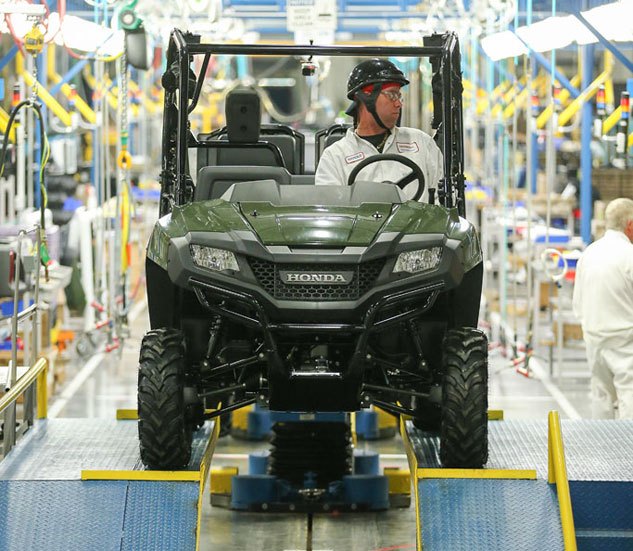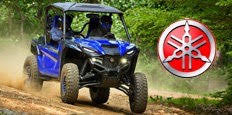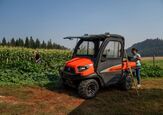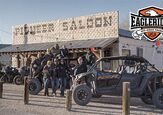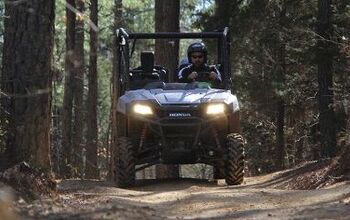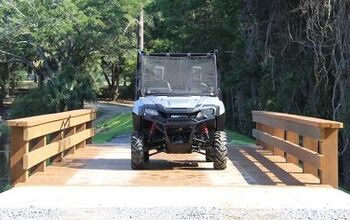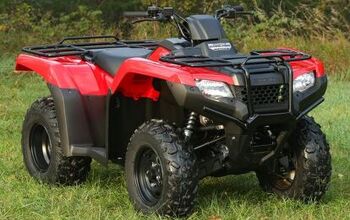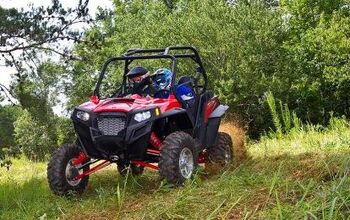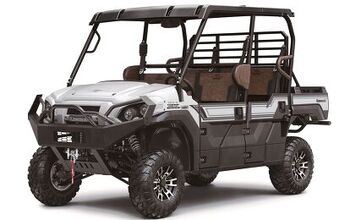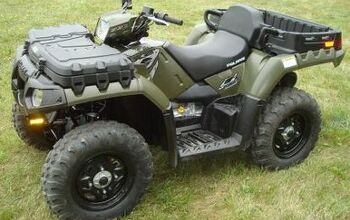2014 Honda Pioneer 700-4 Review
It has been a while since Honda has introduced a new machine, but with the release of the 2014 Honda Pioneer 700 (available in two- and four-seat versions), the wheels seem to be turning once again. Getting the call to attend the Pioneer line off ceremony in Timmonsville, SC, I was excited to get behind the wheel of the newly developed machine.
Visit our Honda Pioneer Forum
First off, this machine was designed by Honda research and development in the great state of Ohio and then assembled in Timmonsville. This machines introduction to the Timmonsville plant added 65 new jobs for locals in South Carolina.
The 2014 Honda Pioneer 700 is available in two- and four-seat models.
Engine placement for the Pioneer was crucial, as the extra seating would be sharing space between the wheels. Getting the big single down low and into a place to be effective as well as best centered for weight distribution was also important. The powerplant is located directly below the driver and front passenger yet it is hardly noticeable on the ride. This combined engineering gives the Pioneer a lower center of gravity for a more stable ride on off-camber terrain.
The power to move the 1396-pound machine comes from the 675cc single cylinder four-stroke engine. This is the same mill used to motivate the Honda Rincon ATV. The engine is liquid cooled and fuel injected for optimum efficiency. Utilizing a 40mm throttle body the engine breathes through the air box, which can be accessed through the floor panel that is forward-center of the two rear seats (Pioneer 700-4 model).
COMPETITION: Read our preview of the 2014 Yamaha Viking
Honda’s familiar 675cc single cylinder four-stroke engine powers the new Pioneer.
While many variations of the CTV (continuously variable transmission) can be found in ATVs and UTVs, Honda relies on a standard hydraulic torque converter that gives the driver a sense of being in an automatic transmission car. Three forward gears as well as reverse make for a smooth ride in or out of most situations. The transmission also boasts 2WD, 4WD and 4WD with differential lock, so the driver has a selection options to deliver power to ground in any situation. Front and rear steel drive shafts deliver the torque and power to Honda’s locking differentials.
Stopping power on the Pioneer comes from huge twin piston calipers on both front wheels clamping down on 200mm discs, which seem a half-inch thick at a glance. Seeing such large braking components on this machine was confidence inspiring to say the least. As well, a 170mm disc on the driveline just before the rear differential supplies braking for both rear wheels. This seems to be a common practice for many manufacturers and our guess is that it saves money on parts, shaves a few pounds off the machine and helps slim it down as well.
One of the things that sets the Pionner apart is it’s two-piece sub-frame assembly.
The chassis of the Pioneer 700-4, as well as the two-seat Pioneer 700, comes in sections. Where most manufacturers have a solid one-piece frame, Honda has designed a two-part sub-frame assembly that comes together near the rear floorboard area. This main chassis design is for the two-person Pioneer with added parts to convert this structure to the four-seat capable machine. Some gear heads may ask, “can you convert a two-person Pioneer to a four using the same structure or chassis?” The answer is yes, but with a huge pile of parts and time. And with the affordability of the machines why not just buy the four-seat version anyway? The two-piece sub-frame keeps the maneuverability of the two-up but with the ability to haul two more in the rear.
Speaking of the four-seat Pioneer 700-4, let’s dig into some of the coolest engineering I’ve seen from Honda. The Honda Pioneer 700-4 is a unique machine in that it has four available seats. The seating is cloaked in the bed of the machine and easily converts for extra riders. The bed when not seating passengers holds a load of up to 1000 lbs. This bed dumps that cargo and can be quickly converted to hold two more riders for a more productive work day. The rear doors open, you raise the seat backs on both sides, drop the lumbar support locking it into place and there you have it, two more seats. Three-point seatbelts are also included in the rear seats and hang inconspicuously from the rear of the protective ROPS-approved roll structure. If you’re wondering just how easy it would be to dump your mother in law out of the rear seats, I’m afraid it’s just not going to happen. Honda outfitted the bed with a locking device that keeps it from rising when either of the rear seats is in the up position. The seats can be lifted independently, so if you need just one seat and a working bed it can be done.
COMPETITION: Read our review of the 2012 Kawasaki Teryx4 750
The first production Honda Pioneer rolls off the line in South Carolina.
After exploring the massive Timmonsville plant, I watched as the first production Pioneer made its way off the line. It was then time to get a helmet and head out to the Honda testing grounds for some short riding time on the machine.
Slipping into the driver’s seat is comfortable and the doors operate smoothly with no slamming needed. The three-point seat belts provide the safety needed when riding, but I wish they came with strain relief or anti-cinch devices on them as it can get a little aggravating on the neck line.
My Pioneer 700-4 fired off and away I went through the flatland. The power of the 675cc engine is sufficient for the machine’s intended use and as always there are many aftermarket companies building parts to drive up the output of the big single. Functionally, this Pioneer is smooth riding and the steering requires little effort. I noticed very little bump steer and it was really refreshing to see a steering geometry that worked very well without power steering. Of course, I always appreciate power steering, but at this price point and after driving it maybe it doesn’t need it? You’ll have to be the judge of that.
Despite the lack of power steering, steering effort is light.
Getting the Pioneer up to speed I noticed the shifting of the transmission felt much like an automobile with three distinct shift points. Top speed reached about 45mph with a rev limiter taking charge right about that point. Sitting in the rear seats for me was a little cramped, but felt comfortable enough. Being six-feet tall, it got a little sketchy on some downhill sections as I tended to slide forward and the seat belts locked me in place.
The suspension of the Pioneer boasts a total of 10.3 inches of ground clearance with 7.9 inches of travel in the front and 9.1 in the rear. This is probably my only real big concern with the machine as the single spring front shocks are pretty soft and non-adjustable. The rear shocks have preload adjustments yet still seem a little tender as well. It was not hard to find the bottom of the travel range while loaded with two large riders in the machine, not to mention four, and if I had to pick one item to focus on for improvement it would be the shocks. I had a chance to drive the two-seat version of the Pioneer as well and felt it to be lighter as well as a bit more powerful and nimble under the steering wheel. But if you take weight off any machine, it gets better every time.
COMPETITION: Read our review of the 2013 Polaris Ranger XP 900
If there is one area of concern on the new Pioneer, it’s the shocks. It’s not hard to bottom them out and they offer no adjustability in the front.
Honda is using the Pioneer to replace the Big Red. The two-seat Pioneer 700 retails for $9,999, while the Pioneer 700-4 will have a price tag of $11,699 – the same as the two-seat Big Red.
Overall I think Honda is really on to something here. When I first heard about the Pioneer four-seat UTV I immediately thought, “why would they put two seats in the bed of the machine and call it a four seater?” But after seeing the new Honda in person I realize not only do you sit down in the machine more than I had imagined, but it also has a very utilitarian mode to its madness. With rumors of four or five more products coming out of the backwoods of South Carolina, I’m anxious to see just what else Honda has been working on.
This is the first new machine we’ve seen from Honda in a while, but it looks like more are on the horizon.
Whether he is in Mexico covering the Baja 1000, building ATVs for local racers, or out enjoying the trails, Rick’s passion shows in his stories. Learning to wrench his own machines from his grandfather, Rick also has an undying appreciation for the mechanics of off-road vehicles. Do not let the dirt and mud fool you, though, as Rick also has a deep love for street cars.
More by Rick Sosebee






